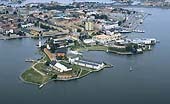By Michael Fabey mike.fabey@aviationweek.com
Source: AWIN Firs

The U.S. Navy’s Littoral Combat Ship (LCS) program will largely sink or succeed on the basis of how well its unmanned systems fare in upcoming tests and operations.
While previous U.S. Navy ships went to sea with organic combat and operational systems aboard, the LCS vessels are outfitted with mission module packages allowing the ship to conduct surface warfare (SUW), mine countermeasures (MCM) or antisubmarine warfare (ASW) missions.
And the strength of those systems — indeed the major selling point for the LCS, especially in conducting some of the more dangerous missions like MCM or ASW — rests largely on the effectiveness of the LCS’s unmanned systems and components.
Much the same can be said of other Navy and Pentagon programs that are investing greater amounts of resources into unmanned systems development. “Anything autonomous is growth,” says Stephen Froelich, Lockheed’s director and general manager of mission and unmanned systems. “Getting humans out of the danger zone is a growth industry.”
And no unmanned system shows more promise to do just that than the MCM mission module package slated for LCS.
“With LCS, there is a lot less danger,” says Peter Adair, = head of the analysis and tactics division at the Naval Surface Warfare Center (NSWC), Panama City, Fla. “The sailors are out of the minefield, using these new remote sensors and systems in the minefields.”
The LCS mine-hunting system sensors — such as the AN/AQS-20A sonar towed by the unmanned and autonomous remote multi-mission vehicle (RMMV) — are meant not only to keep the ships out of danger, but also to manage the missions better.
“With the semi-submersible [RMMV] it’s not just the speed of getting there, but also [the] speed of being inside the mine field,” says Bob Benjamin, the MCM technical program manager for the Panama City NSWC.
MCM operations currently involve detecting mines and then classifying them. But the AN/AQX-20A can detect and classify in the same mission, Benjamin says. When fully implemented, the LCS MCM package will include an AN/AES-1 sonar, the Airborne Laser Mine Detection System (ALMDS) and AN/ASQ-235 Airborne Mine Neutralization System (AMNS), making the LCS a potentially formidable MCM platform compared to the current Avenger-class ships.
It can perform twice as fast,” Froelich says. “It can perform at high speeds. We do preset missions. We call them ‘mowing the grass.’ It goes back and forth. It has different modes such as bottom contour following or volume searches. You have different kinds of searches, depending on the type of water, the type of intelligence you have and the various conops [concepts of operation].”
The U.S. Government Accountability Office (GAO) says the proposed LCS conops for MCM keeps changing, and it is difficult to truly compare the new tactics and equipment with the legacy ones because of new metrics being employed by the Navy to measure mine warfare success.
But LCS program officials say some benefits of using unmanned systems are obvious when the proposed MCM packages are compared to the wooden Avenger-class ships packed with more than 80 sailors plodding through a minefield at a speed of 3-5 kt.
“It’s software, multiple sensors and newer technology,” Adair says. “When we say we can do it twice as fast as legacy, we’re comparing how long does it take to clear this volume of water, top to bottom, to some clearance level.”
He says, “It’s so hard — it’s almost impossible — to assure the admiral who’s coming down in the fleet in a ship [that] there are no mines down there. If you need to know there are no more than two mines in there, I need this amount of time. But if you’re willing to accept that there could be three mines in there, I’ll take a lot less time to cover this area. There are two measures of effectiveness in mine warfare: time and risk. If you give me enough time, I’ll reduce the risk.”
The LCS MCM package combining sensors with manned and unmanned systems, program officials say, make that much easier and safer than what the Navy has now.
